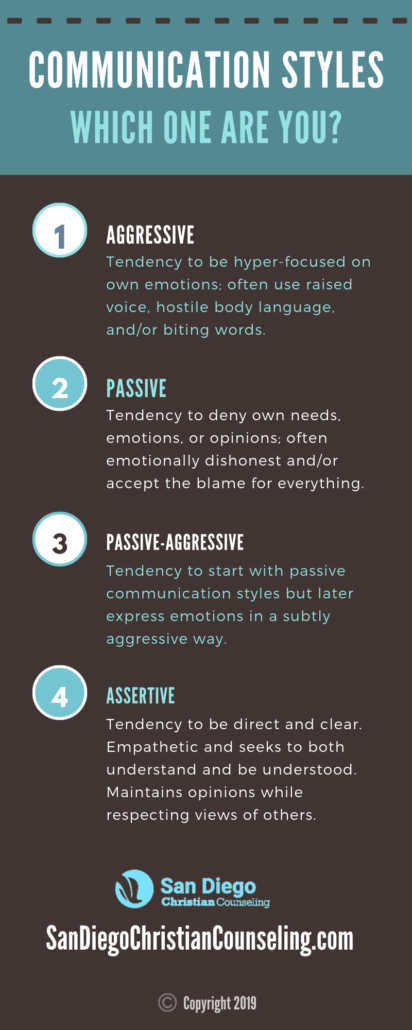There are four general communication styles: assertive, aggressive, passive and passive-aggressive. These categories provide a solid base when discussing communication styles.
It’s true that communication style can vary depending on situation, mood or who you are conversing with. However, most people revert to one of the four communication styles mentioned above. San Diego Christian Counseling can help you understand these styles better. Once you are aware of how you tend to communicate, you can begin taking measures to improve your communication skills.
What’s Your Communication Style?
Let’s discuss each communication style to see which one you relate to the most.

Aggressive
Someone who exhibits an aggressive communication style normally disregards the feelings, emotions, and perspectives of others. This person is laser-focused on their own feelings and views.

Communicating aggressively can come off as being abrasively honest without caring about how that abrasive honestly might be received by the other person. Honesty is a key component to having beneficial communication, but when someone incorporates aggressiveness into their communication style honesty can come off as condemning or blatantly rude.
An example of this might be saying to your roommate who is always leaving messes around the house, “You always leave your filthy clothes on the floor! You are dirty and lazy.” This might be partially true, but the way you delivered the message will only cause the conflict to escalate and not come to a peaceful agreement on next steps.
Those who communicate aggressively come off as attackers to the one on the receiving end. This causes problems because once someone feels attacked or blamed they either become defensive or withdraw which are not healthy for constructive communication. Tempers end up flaring, people say words they regret and a bigger mess is the result.
Hostility, anger, and stubbornness are also qualities often used to describe aggressive communication. Instead of seeking to understand opposing views, aiming for compromise or extending respect for other people in the conversation, aggressive communicators tend to be unwilling to budge in their perspective. Their ability to compromise is lacking.
It doesn’t end at verbal communication either. People who tend to have aggressive communication styles have hostile body language too. This body language coupled with their harsh words can cause fear in others who end up bending to their wishes. Aggressive communication may get you what you want in the short-term, but over time it destroys relationships.
Passive
 A person who communicates passively normally denies their own desires, emotions or opinions. They feel like their voice doesn’t matter and may take the blame for everything, even when it’s not their fault.
A person who communicates passively normally denies their own desires, emotions or opinions. They feel like their voice doesn’t matter and may take the blame for everything, even when it’s not their fault.
You can recognize passive communication if a person constantly apologizes, is a doormat to what other people want, and puts the emotions of others before their own. Let’s take a look at the roommate who leaves clothes all over the house.
A passive person might say, “It doesn’t matter to me. You are so busy.” This deters the communicator from getting their needs met. They desire for the clothes to be picked up, but they want to avoid confrontation, hard conversations or rocking the boat.
It often means that the person sacrifices their needs to keep the peace. This person can become like a volcano about to erupt. After suppressing their true feelings and thoughts they end up exploding suddenly.
Passive-Aggressive
Passive-aggressive communication style is described as using a passive communication style initially, but later using subtle, aggressive forms of non-direct communication.
Let’s take a look again at the roommate with clothes strewn on the floor. The passive-aggressive communicator might say, “This floor sure does have a lot of dirty clothes on it.” Instead of directly asking the roommate to clean up the clothes or even brainstorming ways to keep the area tidy, the passive-aggressive communicator speaks in a non-direct manner.
The also might opt to say anything and then burn with anger internally the longer the clothes are on the ground. This communication style can be received as manipulative or dishonest and can create constant tension in relationships.
Assertive
Everybody looks to assertive communication as the ultimate communication style to create healthy and growing relationships. Assertive communication is direct, clear and leaves no ambiguity. The assertive communicator is able to show respect for other people while maintaining their own beliefs and feelings.
![]() Assertive communication seeks to both understand and be understood. This person doesn’t have to fight to be right but is able to find a compromise. Of course, compromise isn’t always the answer and there are times and circumstances when you should stand your ground on a subject and have firm boundaries. It’s important to do this in an assertive way rather than an aggressive way. An assertive communicator can identify when to cool down and allow some time before responding.
Assertive communication seeks to both understand and be understood. This person doesn’t have to fight to be right but is able to find a compromise. Of course, compromise isn’t always the answer and there are times and circumstances when you should stand your ground on a subject and have firm boundaries. It’s important to do this in an assertive way rather than an aggressive way. An assertive communicator can identify when to cool down and allow some time before responding.
Keeping the above statement in mind, an assertive communicator might say, “I noticed that you continue to leave your clothes on the ground in our shared space which leaves me frustrated when I get home. I know you’ve had a hectic schedule lately, but is there a way we can keep the house tidy on a consistent basis?”
An assertive communicator focuses on nonverbal communication as well which may mean displaying a safe smile or refraining from using a sarcastic tone when speaking.
Active Listening
Active listening is crucial during communication. Active listeners aren’t thinking about what they need to do after the conversation or what they want to say next. Active listening is giving your full attention to someone, trying to understand what they are saying, and showing that you are engaged in the conversation.
This creates a productive conversation. The two parties end up feeling heard and respected. It compels the other person to model the same level of respect when it’s your turn to talk. Active listening creates an environment of safety and promotes healthy communication. Both parties can be vulnerable without fear or repercussions.
Here are a few ways to practice effective active listening:
- If you notice your mind beginning to wander (thinking about dinner), gently redirect it back to what the person is sharing. Active listening does take work, especially in today’s distracted world, but once you master it you will notice an improvement in your relationships.
- Don’t disregard their body language. It’s not always what they are saying, but how they say it. Take the full picture into account as you seek to understand the message being sent.
- Avoid thinking ahead to what you want to say next. This can happen almost without you noticing. You must be aware when your thoughts are not aligned with what the person is sharing. The more you practice, the better you will become.
- You can show you’re engaged with the conversation by nodding your head or encouraging the speaker to continue to share. Feedback is important in communication and these are small ways to not interrupt the speaker, but still, show you are with them. Avoid showing disinterest by checking your phone, looking at your watch or even staring out the window. Your body language will speak loudly during active listening moments.
 Summarize what the person has said at the end of the conversation. If the speaker didn’t ask for your advice, shy away from offering your advice. Instead of offering advice, you can repeat what you heard. If someone tells you their boyfriend doesn’t call them every night. Instead of saying, “It sounds like you are not a priority to him.” It’s better to say, “It sounds really hurtful that he doesn’t call every night to talk to you.” She might tell you that she’s not hurt, but annoyed instead. This puts you guys on the same page.
Summarize what the person has said at the end of the conversation. If the speaker didn’t ask for your advice, shy away from offering your advice. Instead of offering advice, you can repeat what you heard. If someone tells you their boyfriend doesn’t call them every night. Instead of saying, “It sounds like you are not a priority to him.” It’s better to say, “It sounds really hurtful that he doesn’t call every night to talk to you.” She might tell you that she’s not hurt, but annoyed instead. This puts you guys on the same page.- Ask open-ended questions to draw out more to the conversation. In the above scenario, an open-ended question would be, “How can I support you as you navigate this relationship?” This gives the speaker time to reflect and build on what they are sharing. They will draw their own conclusion and may have specific revelations that weren’t there before.
- Validate the person who is speaking even if you aren’t in complete agreement. Validation shows empathy and helps a person feel heard even if you disagree with each other. Let’s say a person thinks her boss is unfair. However, you have a different perspective that person on the boss in question. You can still say, “It sounds like you are having a hard time a work and I’m sorry to hear about the frustration.”
Concluding Thoughts
Communication is complex and vast. There are many strategies and techniques to try depending on the person, situation and context. Everybody makes communication mistakes. A good place to start is by paying attention to how others make you feel in situations. Do you feel validated? Understood? Respected?
You can learn from the situations that leave you feeling heard and the ones that leave you feeling misunderstood. Begin implementing what works and avoid what doesn’t work. If you feel supported when someone smiles, nods and makes eye contact, you can experiment with these same strategies.
If you find yourself annoyed when a friend is constantly on their phone or saying “Yeah” too often during communication, you can avoid this in your approach. Lastly, pay attention to your interactions to identify which relationships have healthy communication and which relationships have room to grow. If you want extra support in growing in your communication skills, reach out to a counselor at San Diego Christian Counseling today.
“Can Chat Chatting”, Courtesy of Gratisography, Pexels.com; CC0 License; “In the Moment”, Courtesy of Trung Thanh, Unsplash.com, CC0 License; “Coffee Shop Confrontation”, Courtesy of Rawpixel, Unsplash.com, CC0 License; “Communication”, Courtesy of Rawpixel, Unsplash.com, CC0 License


